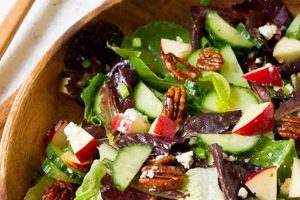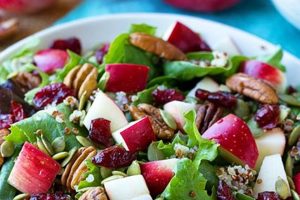A guide to preparing the classic Waldorf salad typically involves a combination of crisp apples, celery, walnuts, and grapes, dressed in a mayonnaise-based sauce. Variations may include other ingredients such as raisins, dried cranberries, or chicken. A well-written instructional document will offer precise measurements and clear instructions, ensuring consistent results.
This dish offers a refreshing balance of sweet and savory flavors, with contrasting textures from the crunchy produce and nuts against the creamy dressing. Its enduring popularity stems from its simplicity, versatility, and adaptability to diverse palates. Originating at the Waldorf-Astoria Hotel in New York City in the late 19th century, this culinary creation has become a staple in restaurants and homes worldwide. It serves as a light meal, side dish, or appetizer, suitable for various occasions from casual gatherings to elegant events.
This exploration will delve into variations, ingredient selection, preparation techniques, and presentation suggestions to enhance the culinary experience and elevate this simple salad to a new level of sophistication.
Tips for a Superior Waldorf Salad
Elevating this classic dish requires attention to detail and an understanding of the interplay of flavors and textures. These tips offer guidance on optimizing ingredient selection, preparation methods, and presentation.
Tip 1: Apple Selection is Key: Opt for firm, tart apples like Honeycrisp, Braeburn, or Granny Smith. Their crisp texture and tartness provide a refreshing contrast to the creamy dressing and sweetness of other ingredients. Avoid overly ripe or mealy apples, as they can compromise the salad’s texture.
Tip 2: Enhance the Celery: Use crisp, inner celery stalks for the best flavor and texture. Consider briefly blanching the celery in boiling water for a milder flavor and slightly softened texture if desired.
Tip 3: Toast the Walnuts: Toasting walnuts intensifies their nutty flavor and adds a delightful crunch. Spread them on a baking sheet and toast in a preheated oven at 350F (175C) for 5-7 minutes, or until fragrant.
Tip 4: Dressing Consistency Matters: The dressing should be creamy and coat the ingredients evenly, but not overly thick. Adjust the mayonnaise-to-yogurt ratio (if using) for desired consistency. A touch of lemon juice can brighten the flavor profile.
Tip 5: Freshness is Paramount: Prepare the salad shortly before serving to prevent the apples and celery from browning and maintain optimal texture. If preparing in advance, toss the apple pieces with a little lemon juice to inhibit oxidation.
Tip 6: Consider Ingredient Variations: Dried cranberries or raisins offer a sweet and tart counterpoint. Diced grapes add a juicy burst of sweetness. For a heartier salad, add grilled chicken or cooked shrimp.
Tip 7: Presentation Enhances the Experience: Serve the Waldorf salad on crisp lettuce leaves, in endive cups, or arranged artfully on a platter. Garnish with additional walnut halves, grapes, or a sprinkle of fresh herbs.
By following these guidelines, one can create a Waldorf salad that surpasses expectations, delivering a harmonious blend of flavors, textures, and visual appeal.
This attention to detail enhances not only the taste but also the overall dining experience, transforming a simple salad into a culinary masterpiece.
1. Ingredients
The quality and selection of ingredients directly impact the final outcome of a Waldorf salad. Each component contributes a specific flavor and texture, creating a balanced and harmonious dish. Apples provide sweetness and crispness; celery adds a refreshing crunch; walnuts offer a rich, nutty element; and the mayonnaise-based dressing binds the ingredients together while adding a creamy texture. The interplay of these elements is crucial; subpar ingredients or improper proportions can compromise the overall result. For instance, using mealy apples instead of crisp ones will result in a less satisfying texture. Similarly, stale walnuts will lack the desired crunch and flavor depth. The selection of each ingredient is therefore fundamental to achieving the intended flavor profile.
Furthermore, understanding the role of each ingredient allows for informed substitutions and variations. While the classic recipe calls for specific components, variations can be introduced to cater to individual preferences or dietary restrictions. For example, Greek yogurt can replace or supplement mayonnaise for a lighter, tangier dressing. Grapes or dried cranberries can be added for extra sweetness and visual appeal. These modifications, however, require careful consideration of how they will impact the overall balance of flavors and textures. A successful variation maintains the essence of the Waldorf salad while adding a unique twist.
In conclusion, the ingredients of a Waldorf salad are not merely a list of components, but rather the foundation upon which the success of the dish rests. Careful selection, proper proportions, and an understanding of the interplay of flavors and textures are paramount in creating a truly exceptional Waldorf salad. This knowledge empowers culinary exploration, enabling both adherence to tradition and creative adaptation.
2. Proportions
Proportions play a crucial role in a Waldorf salad, determining the balance between sweetness, tartness, creaminess, and crunch. The ratio of apples to celery influences the overall texture and flavor profile. Too much apple can make the salad overly sweet, while an excess of celery might result in a predominantly vegetal taste. The amount of dressing relative to the other ingredients affects the salad’s richness and moistness. An insufficient amount of dressing can lead to a dry, less flavorful salad, while an excessive amount can overpower the other ingredients and make the salad heavy. The quantity of walnuts impacts the textural contrast and the intensity of the nutty flavor. Too few walnuts might leave the salad lacking in crunch, while too many could overwhelm the delicate flavors of the apple and celery.
Consider a scenario where the recipe calls for two apples, one stalk of celery, and cup of walnuts. Doubling the amount of apples while keeping the other ingredients constant would shift the balance towards sweetness, potentially masking the celery’s refreshing contribution. Conversely, reducing the walnuts to a mere tablespoon might diminish their textural impact, resulting in a less satisfying experience. A successful Waldorf salad relies on the harmonious interplay of its components; achieving this harmony hinges on maintaining the correct proportions. This understanding allows for informed adjustments based on personal preference while ensuring the fundamental character of the salad remains intact.
Achieving optimal proportions requires careful consideration of the recipe and the desired outcome. While variations exist, adhering to a well-established recipe provides a solid foundation. Subsequent adjustments can be made based on individual taste preferences, but a clear understanding of the impact of these alterations is essential. Mastery of proportions elevates the Waldorf salad from a simple combination of ingredients to a carefully balanced and nuanced culinary creation. This precision contributes not only to the flavor but also to the overall textural complexity, ensuring a delightful and harmonious dining experience.
3. Preparation method
The preparation method significantly influences the final quality and enjoyment of a Waldorf salad. Careful attention to each step, from ingredient preparation to final assembly, ensures optimal flavor, texture, and presentation. The order of operations and specific techniques impact the overall outcome. For example, chopping the apples and celery into uniform pieces ensures even distribution of flavors and a pleasing texture. Tossing the apple pieces with lemon juice immediately after cutting prevents browning and preserves their fresh appearance. Gently folding the ingredients together with the dressing, rather than vigorous mixing, prevents the salad from becoming bruised and soggy.
Consider the impact of two different approaches. In one scenario, the apples and celery are chopped coarsely and unevenly, the apples are allowed to brown before dressing, and the salad is mixed roughly. The result is a visually unappealing salad with inconsistent texture and compromised flavor. In contrast, meticulous attention to detailuniform chopping, preventing browning, and gentle mixingyields a salad that is both visually attractive and palate-pleasing. This comparison highlights the direct relationship between preparation method and the final quality of the dish.
Precise execution of the preparation method, therefore, directly translates to a superior Waldorf salad experience. Adhering to established techniques and understanding the underlying principles behind each step maximizes the potential of the ingredients, ensuring a harmonious blend of flavors, textures, and visual appeal. This careful approach elevates the salad from a simple combination of components to a carefully crafted culinary creation. Mastery of the preparation method allows for consistent results and enhances the enjoyment of this classic dish.
4. Variations
The classic Waldorf salad, while delicious in its traditional form, lends itself to a surprising array of variations. These adaptations demonstrate the recipe’s inherent flexibility, allowing for personalized interpretations while retaining its fundamental character. Variations arise from ingredient substitutions, additions, and alterations to the dressing. These modifications cater to diverse palates, dietary needs, and seasonal ingredient availability. For instance, the traditional mayonnaise-based dressing can be lightened with Greek yogurt or replaced entirely with a vinaigrette for a tangier, lower-fat option. Adding dried cranberries or golden raisins introduces a burst of sweetness and chewiness, complementing the apple’s tartness. Incorporating grilled chicken or roasted chickpeas elevates the salad to a more substantial meal, offering a protein-rich alternative.
The practical significance of understanding these variations lies in the ability to tailor the recipe to specific circumstances. Consider a summer picnic: a lighter Waldorf variation featuring a yogurt-based dressing and fresh berries aligns perfectly with the occasion. Conversely, a holiday gathering might call for a more elaborate version with roasted pecans, dried apricots, and crumbled blue cheese. Recognizing the potential for adaptation expands the Waldorf salad’s utility, transforming it from a specific dish into a versatile template adaptable to a range of scenarios. Furthermore, exploring variations encourages culinary creativity, fostering a deeper understanding and appreciation of flavor profiles and ingredient combinations.
Exploring variations not only broadens the appeal of the Waldorf salad but also offers insights into culinary principles. The success of a variation hinges on a balanced approach. Substituting ingredients requires careful consideration of their impact on the overall flavor and texture profile. Introducing new components should complement, not overwhelm, the existing elements. A well-executed variation retains the essence of the Waldorf salad while adding a distinctive twist. This principle of balanced adaptation extends beyond the specific recipe, offering valuable lessons applicable to broader culinary endeavors. Understanding the interplay of flavors and textures empowers culinary experimentation and fosters a deeper appreciation for the art of cooking.
5. Serving Suggestions
Serving suggestions enhance the presentation and enjoyment of a Waldorf salad, elevating it from a simple mixture to a visually appealing and thoughtfully presented dish. Consideration of serving style, accompanying dishes, and appropriate occasions maximizes the salad’s potential, transforming it from a basic side dish to a star attraction.
- Presentation Styles
The visual presentation of a Waldorf salad contributes significantly to its perceived value and enjoyment. Traditional service in a bowl allows for easy serving but lacks visual flair. More elaborate presentations, such as individual portions served on lettuce cups, in endive spears, or arranged artfully on a platter, enhance the dining experience. Garnishing with additional walnut halves, grapes, or a sprinkle of fresh herbs further elevates the presentation. The choice of serving style should align with the formality of the occasion and the overall meal composition.
- Complementary Dishes
Waldorf salad’s versatility allows it to complement a wide range of main courses. Its refreshing qualities make it an ideal accompaniment to richer dishes like roasted meats or grilled fish. The salad’s sweetness and crunch provide a pleasant contrast to savory flavors and heavier textures. Consideration of the main course’s flavor profile and overall meal composition ensures a balanced and harmonious dining experience. For example, a Waldorf salad with a lighter vinaigrette dressing pairs well with grilled chicken or fish, while a creamier version complements roasted pork or beef.
- Suitable Occasions
The Waldorf salad’s adaptability extends to various occasions, from casual lunches to elegant dinners. Its refreshing nature makes it a perfect choice for picnics, buffets, and light summer meals. For more formal occasions, a carefully plated and garnished Waldorf salad can serve as an elegant appetizer or side dish. The versatility of the salad allows it to transition seamlessly between different settings, adding a touch of sophistication to any meal. Its adaptability also makes it a convenient and crowd-pleasing option for potlucks and gatherings.
- Customization and Adaptation
Serving suggestions can be customized to reflect personal preferences and dietary restrictions. Individual portions allow for adjustments to ingredient ratios and dressing choices. Offering a variety of garnishes, such as toasted nuts, dried fruits, or crumbled cheese, empowers diners to personalize their salads. This flexibility enhances the appeal of the Waldorf salad, ensuring its relevance to a broader audience and catering to diverse tastes. For instance, providing gluten-free crackers or bread alongside the salad caters to guests with dietary sensitivities.
Thoughtful consideration of serving suggestions demonstrates an attention to detail that elevates the Waldorf salad experience. By understanding the interplay between presentation, complementary dishes, suitable occasions, and customization options, one can transform this classic salad into a culinary centerpiece, enhancing both its visual appeal and gastronomic enjoyment. These considerations demonstrate a commitment to culinary excellence, transforming a simple salad into a thoughtfully presented and thoroughly enjoyable dish.
6. Flavor Profile
The flavor profile of a Waldorf salad represents a carefully balanced interplay of sweet, tart, creamy, and crunchy elements. This characteristic balance distinguishes the salad and contributes to its enduring appeal. The sweetness derives primarily from the apples, with variations in intensity depending on the variety chosen. Tartness, often provided by the same apples or augmented by a touch of lemon juice in the dressing, counterbalances the sweetness, preventing the salad from becoming cloying. Creaminess comes from the mayonnaise-based dressing, which binds the ingredients and provides a smooth textural contrast to the crisp components. The crunch, contributed by the celery and walnuts, adds a textural dimension essential to the overall sensory experience. Disruptions to this balance, such as an overly sweet apple variety or an insufficient amount of walnuts, can compromise the intended flavor profile.
The careful orchestration of these elements is essential for a successful Waldorf salad. For example, using a sweeter apple like Fuji requires a more judicious use of added sugars in the dressing, or perhaps the incorporation of a tart element like dried cranberries to maintain balance. Similarly, substituting pecans for walnuts introduces a different type of nuttiness, potentially altering the overall flavor profile. Understanding the intended flavor profile empowers informed decision-making regarding ingredient selection and preparation techniques. A well-executed Waldorf salad exemplifies the principle of balance, demonstrating how contrasting elements can harmonize to create a complex and satisfying culinary experience. Substituting crumbled blue cheese for the traditional walnuts, for instance, introduces a pungent, salty dimension that requires careful balancing of the other ingredients to avoid overwhelming the palate.
Mastery of the Waldorf salad’s flavor profile extends beyond simply following a recipe; it involves understanding the interplay of ingredients and how their individual characteristics contribute to the whole. This understanding allows for adaptation and improvisation while maintaining the essence of the dish. Recognizing the importance of balance, contrast, and complementary flavors elevates the Waldorf salad from a simple combination of ingredients to a nuanced culinary creation. The practical application of this knowledge lies in the ability to create consistently delicious and balanced Waldorf salads, regardless of minor variations in ingredients or preparation techniques. This mastery ultimately enhances appreciation for the culinary arts and empowers informed exploration of flavor profiles in other dishes.
7. Historical Context
The Waldorf salad, far from being a static recipe, carries a rich history that informs its present form. Its origin in the late 19th century at the Waldorf-Astoria Hotel in New York City provides crucial context for understanding its evolution and enduring popularity. Initially created by Oscar Tschirky, the hotel’s matre d’htel, the original recipe consisted simply of apples, celery, and mayonnaise. This stark simplicity reflects the culinary trends of the era, emphasizing fresh, raw ingredients. The subsequent addition of walnuts, and later grapes, demonstrates how the recipe adapted to evolving palates and culinary fashions. Understanding this historical trajectory provides insight into the dish’s core identity and the rationale behind its ingredient combinations.
The Waldorf salad’s association with the prestigious Waldorf-Astoria contributed significantly to its widespread adoption. The hotel’s reputation for elegance and sophistication conferred a certain status upon the dish, elevating it beyond a simple salad. Its inclusion on the hotel’s menu exposed it to a wide and influential audience, facilitating its dissemination through cookbooks and social circles. This historical context underscores the social and cultural factors that propelled the Waldorf salad to prominence. The dish’s evolution mirrors broader culinary trends, reflecting changing tastes and ingredient availability. For example, the original absence of nuts likely reflects their relative scarcity and expense at the time. The later incorporation of walnuts coincided with their increased availability and affordability, demonstrating the influence of economic factors on culinary practices.
Appreciating the historical context of the Waldorf salad enriches the contemporary culinary experience. It provides a deeper understanding of the dish’s evolution, highlighting the reasons behind its enduring popularity. This knowledge allows for informed interpretations and adaptations of the recipe, enabling cooks to honor its historical roots while incorporating modern twists. Moreover, understanding the social and cultural context of the Waldorf salad adds a layer of appreciation beyond its simple ingredient list. Recognizing the dish’s historical journey transforms it from a mere combination of ingredients into a culinary artifact, reflecting the evolving tastes and cultural influences of past generations. This awareness allows for a more nuanced and meaningful engagement with culinary history, fostering a deeper appreciation for the dynamic interplay between food and culture.
Frequently Asked Questions
This section addresses common inquiries regarding the preparation and variations of Waldorf salad, offering practical guidance and clarifying potential misconceptions.
Question 1: Can red-skinned apples be used in a Waldorf salad?
While traditional recipes favor green apples for their tartness, red-skinned apples can be used. However, their sweetness may require adjustments to the dressing or the inclusion of more tart ingredients to maintain balance. Choose firm, crisp varieties like Honeycrisp or Pink Lady to ensure optimal texture.
Question 2: How can browning of the apples be prevented?
Tossing the cut apples with a small amount of lemon juice inhibits enzymatic browning, preserving their fresh appearance. This technique is especially important if the salad is prepared in advance.
Question 3: What can be substituted for mayonnaise in the dressing?
Plain Greek yogurt offers a lighter, tangier alternative to mayonnaise, either as a partial or complete substitution. Alternatively, a vinaigrette dressing can be used for a non-dairy option.
Question 4: Can Waldorf salad be made ahead of time?
While best served fresh, Waldorf salad can be prepared a few hours in advance. To maintain optimal texture, keep the dressed salad chilled and add the walnuts just before serving to preserve their crunch.
Question 5: What are some suitable additions to a classic Waldorf salad?
Dried cranberries, raisins, grapes, and toasted nuts enhance the flavor and textural complexity. For a more substantial meal, consider adding grilled chicken, shrimp, or chickpeas.
Question 6: How should Waldorf salad be stored?
Store leftover Waldorf salad in an airtight container in the refrigerator for up to two days. The texture may soften slightly over time due to the dressing.
Understanding these common inquiries allows for informed choices in preparing and adapting Waldorf salad to suit individual preferences and dietary needs. Successful preparation hinges on attention to detail and a clear grasp of the underlying principles that govern this classic dish.
The following sections will explore specific recipes and offer further guidance on elevating your Waldorf salad experience.
Conclusion
Exploration of the Waldorf salad recipe reveals a dish defined by simplicity, adaptability, and enduring appeal. From its origins at the Waldorf-Astoria Hotel to its current variations, the salad’s core componentsapples, celery, walnuts, and a mayonnaise-based dressingoffer a balanced interplay of sweet, tart, creamy, and crunchy elements. Careful attention to ingredient selection, proportions, and preparation methods ensures a harmonious blend of flavors and textures, while an understanding of its historical and cultural context enriches the culinary experience.
The Waldorf salad stands as a testament to the enduring power of culinary tradition. Its adaptability allows for continued innovation and personalization, ensuring its relevance in contemporary cuisine. Further exploration of variations and thoughtful presentation elevates this classic dish, transforming a simple combination of ingredients into a culinary expression of creativity and sophistication. One is encouraged to embrace the foundational elements while exploring the possibilities, preserving the legacy of this iconic salad for future generations.






